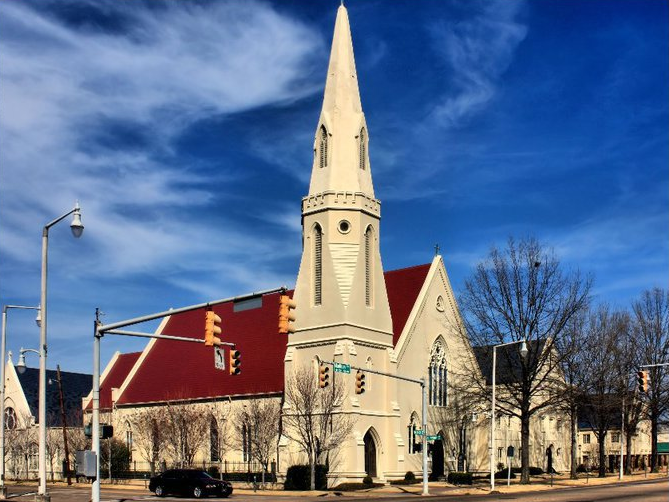St. John’s is considered one of Montgomery, and Alabama’s, most important landmarks. As the oldest Episcopal parish in Montgomery, St. John’s was organized in 1834 by a small group of early Montgomery settlers. Although Episcopalians were smaller in number compared to other denominations in Montgomery, by 1837, the parishioners of St. John’s completed the first structure, which stood on the northeast corner of North Perry and Jefferson Streets. It was the first brick church in Montgomery.
By the late 1840’s, Montgomery was the capital of the state, as well as the most important shipping center in region. With the influx of population in Montgomery, the congregation of St. John’s also grew. In 1855, a new, larger church building, designed by the foremost church architects, Wills & Dudley of New York, was built in the Gothic style on the northeast corner of North Perry and Madison Avenue, facing Madison.
In 1861, St. John’s was host to Southern Bishops for the Secession convention of Southern Churches. During this convention, the Confederate Episcopal Church was formed, as well as the naming of the University of the South at Sewanee. While the seat of the Confederate Government was in Montgomery, President Jefferson Davis and his family attended services at St. John’s. Their pew is now located in the history room of the church. After Union General Wilson captured Montgomery in 1865, St. John’s, along with all Episcopal churches in the South, was forced to close. The closure was due to the fact the Southern Episcopal Churches refused to add the prayer for the Union President back to its Liturgy. However, services took place in various parishioners’ homes until the church was reopened in 1866.
Despite War Between the States and the awful aftermath of Reconstruction, St. John’s found a way to grow. More room was needed in the church, so, in 1869, the original brick structure on Jefferson Street was taken down and the bricks were used for construction of the current chancel and sanctuary. In 1906, Italian mosaic tiles were installed for the floor of the 1869 chancel. It was also in 1906 that the church decided to do away with pew ownership. A sign was placed close to the entrance stating “All Pews Are Free. Strangers Are Welcome.”
The church was closed, along with other buildings, in 1918 due to the deadly Spanish flu epidemic. Also in 1918, the small Chapel was given to the church. Over the years, the Chapel has been used by other denominations, most notably the Lutheran and Greek Orthodox Churches, until they constructed their own places of worship.
One of the most interesting features of St. John’s are the hand painted ceiling medallions. Rector Horace Stringfellow designed the medallions and painted them in 1869 on the wood plank ceiling of the church. Other interesting fixtures of St. John’s are the 1885 bell chimes installed in the 1855 bell tower, more than 400 individual needlepoint prayer kneelers, and numerous decorations in the garden. One of the breathtaking features of St. John’s is its numerous memorial stained glass windows. The windows include work by Charles Connick of Boston and Louis Tiffany of New York. St. John’s is sometimes referred to as the “Church of the Angels” due to the numerous brass, marble, and wooden statues of angels, which can be seen from any pew in the church.
The church recently completed its first major addition and renovation since the 1950’s. This has allowed St. John’s to expand its involvement in the community.
St. John’s has played a major role in the history of Montgomery, the state of Alabama, and the nation as a whole. It is open everyday but Saturday, and is visited daily by many tourists who come to see its interesting architecture, decorations, and read of its fascinating history.
Chris’ Hotdogs is located only a few blocks from St. John’s. Over the years, many parishioners have made their way over to Dexter to enjoy a delicious meal.

